Enough Equipment
-
- The Macondo Spill Trial Marine News, Apr 2013 #26
Offshore U.S. Gulf energy operators have already paid a steep price; more pain could come.
Drilling in the Gulf of Mexico is now close to levels seen before the April 2010 Macondo spill that took 11 lives and caused the nation’s worst offshore oil spill. Almost two years after the disaster, companies operating in the Gulf are trying to comply with safety requirements finalized last year, according to the Bureau of Safety and Environmental Enforcement. BSEE’s new safety rules for offshore drillers set standards for casing and cementing, third-party certification and verification; blowout preventer capabilities, testing and documentation and well-control training. BSEE now requires documentation from rig operators that its contractors, including offshore supply vessel owners, have a Safety and Environmental Management System or SEMS program in place.
But offshore drilling remains inherently dangerous, and companies are in it to make a profit. The bigger ones report to shareholders. Testimony in the Gulf spill trial, underway in U.S. District Court in New Orleans, is alleging that offshore operators sometimes cut corners, putting profits above safety.
Before the spill, government fines for violations were considered a cost of doing business. And even with new regulations and heightened awareness about safety, a temptation to defer maintenance on vessels and equipment remains. Fines for failing to comply in a timely way arguably weren’t particularly burdensome before the 2010 spill and still aren’t.
Trial Examines Profits vs. Safety
In an admiralty trial that began on Feb. 25 without a jury, U.S. District Judge Carl Barbier in New Orleans is deciding blame between Transocean, BP and Halliburton in the Macondo well explosion. Swiss-based Transocean, the world’s top offshore drilling contractor, owned the Deepwater Horizon rig at the well. U.K.-based BP PLC leased the site from the feds and operated the well. Halliburton, headquartered in Houston and Dubai, was contracted by BP to provide cement.
Judge Barbier also considered liability on the part of Cameron, the maker of the blowout preventer sold to Transocean, and M-I LLC, which was contracted by BP to provide drilling fluids. But Barbier dismissed charges against Cameron and M-I in mid-March, saying he’d heard nothing to indicate they contributed to the blowout.
Testimony about what happened on the Deepwater Horizon, a submersible drilling unit, has focused on negligence in a dangerous, offshore environment. In the accident, workers prepared to temporarily cap the Macondo well more than 4,000 feet under water when it exploded.
On March18, Geoff Webster, the plaintiffs’ expert witness on the Horizon’s seaworthiness, told the court that delayed maintenance had been a growing problem. Rig audits “clearly show that there were not enough people on board, there was not enough equipment for spares and the rig was going downhill,” he said. The rig was in trouble mechanically, hydraulically and probably electrically, Webster said. Maintenance was behind on everything from pumps and alarms to lifeboats. The rig’s blowout preventer hadn’t been recertified in nine years though certification was required every five years by the federal Mineral Management Service and by Cameron, the BOP’s manufacturer.
The rig’s maintenance duties were being closed out or checked off a list though the required tasks often weren’t performed, Webster said. Audits showed “there is no follow-up going on. There is no follow-up by the crew themselves, and there is no follow-up by the shore maintenance people, the rig manager and then ultimately the designated person,” he testified.
When asked what he thought of the vessel’s maintenance history, Webster termed it “reckless neglect.” He said, “This rig should have gone to a shipyard, at which time all these items could have been taken care of. The vessel had been running for nine years without any major overhaul or any dry dock period.”
In September 2009, Transocean engaged Lloyd’s Register Group, a maritime and risk-management organization, to study five of its drilling rigs, including the Deepwater Horizon—following four deaths on four of its rigs over 92 days. In a related July 2010 report, Lloyd’s pointed to “a fundamental lack of hazard awareness” within Transocean’s North America division.
In his mid-March testimony at the trial, Webster was asked about a comment from a Transocean employee included in Lloyd’s analysis of the company’s North American rigs. The employee had said “run it, break it, fix it. That’s how they work.” Transocean was more interested in production than safety, Webster told the court. “When the rig is idle, it’s not making money,” he explained. “When the rig is in dry dock, it’s not making money. So they try to keep it out there as long as they can.”
Lloyd’s also found “a significant level of reported mistrust between the rigs and the beach” at Transocean’s North American operations. Webster said, “That can lead to disaster because the crew are not telling the shore people exactly what’s going on; they are not reporting near-miss accidents; they are not reporting major hazards.” He also said “the crew is afraid to report accidents [and] nonconformities to the office for fear of being fired.”BP Knew of Problems on Transocean’s Rig
In his opening statement at the start of the trial, James Roy of Domengeaux Wright Roy & Edwards, LLC in Layette, La., a plaintiffs’ lawyer representing individuals and businesses, pointed a finger at BP, Transocean and Halliburton.
Roy said BP was aware of design and maintenance problems on the Deepwater Horizon but nonetheless chartered the rig in late 2009 to finish the Macondo well. BP’s executives pressured BP rig management to reduce costs by cutting corners and rushing through work. Roy said “Macondo was described variously by BP personnel as the well from hell, a nightmare well and a crazy well.” He said a push to complete the well caused so many changes to plans that John Guide, BP’s wells-team leader in Houston, said three days before the disaster “the well-site leaders have finally come to their wits’ end.”
Roy said BP’s executives created a culture that valued profit and production over safety. From 2008 to 2009, BP management slashed costs by $4 billion and laid off 20% of its world workforce, with plans for another $1.4 billion in cuts in 2010.
Tidewater’s Damon Bankston, Working Next To Rig, Saved Most of Its Crew
The Deepwater Horizon was located 41 miles off Louisiana’s coast in Mississippi Canyon block 252, with a 126-member crew when it exploded on April 20, 2010. Nine Transocean personnel and two M-I employees died. As things went terribly wrong on the rig, Tidewater’s supply vessel, Damon B. Bankston, was anchored alongside it, ready to help. The Damon B. was pumping heavy drilling mud from the rig through a hose when a flood of mud poured off the rig’s drill deck, according to testimony from the vessel’s captain Alwin Landry to a federal panel in May 2010. He was advised by coworkers that evening to disconnect the hose and move his vessel away from the rig.
In his 2010 testimony, Landry said he heard a loud hiss that lasted for 30 seconds or more. It was later attributed to a surge of methane rushing up the drill pipe to the rig’s deck. A distress call went out from the rig’s radio. An explosion occurred at 9:50 p.m. As fire enveloped the rig, Deepwater Horizon workers rushed to life boats and some of them plunged into the sea, Landry said. The rig’s two lifeboats cleared the burning rig but a smaller life raft couldn’t get free. A Damon Bankston rescue boat pulled up next to the trapped life raft and handed its crew a knife, which they used to cut free, Landry said. Eventually, Damon B. Bankston’s crew rescued 115 workers from the rig.
Outlook: Safety Stepped Up, but Enforcement not Enough
Last month, Eileen Angelico, New Orleans-based spokeswoman for BSEE, said that following the April 2010 explosion, “offshore operators are required to ensure that their contractors have a Safety and Environmental Management System or SEMS program in place. The two new regulations published since Deepwater Horizon are the Drilling Safety Rule and the Workplace Safety Rule or Safety and Environmental Management System.” She added “I’m not aware of any provisions with the Drilling Safety Rule that affect OSVs.”
BSEE doesn’t make demands directly on contractors, she said. “BSEE requires documentation or demonstration from the operator that its contractors exercise a Safety and Environmental Management System program.”
Meanwhile, the offshore enforcement process is more stringent than it was before the Macondo blowout, but not greatly so. Inspectors continue to conduct mostly scheduled reviews of drilling rigs, and they issue incidents of non-compliance for violations--starting a process that can lead to civil penalties but seldom does. Companies have several opportunities to appeal citations and proposed penalties.
Civil penalties are capped at $40,000 per incident a day – an amount some say is not enough for oil companies spending up to $600,000 a day to rent a drilling rig.
The Macondo tragedy has already cost BP and Transocean dearly. BP has spent or committed over $37 billion for cleanup, restoration, payouts, settlements and fines (so far), still facing billions more in. On January 29, BP pleaded guilty in Eastern District Court of Louisiana to 14 criminal counts, including 11 felony counts of manslaughter, and it agreed to pay $4 billion in penalties in the biggest U.S. criminal resolution ever. On Feb. 14, Transocean was fined $1 billion after pleading guilty to one misdemeanor count of violating the Clean Water Act, and agreed to pay another $400 million in criminal penalties.
Looking Forward
Phase One of the spill trial is expected to continue to late April, barring a settlement before then. A Phase Two trial could start in September to examine spill-response evidence and the amount of oil that escaped the well. A third phase, probably in 2014, will consider environmental and economic damages. Energy producers will be watching all of it closely, benchmarking their operations and trying to ensure that they do not suffer a similar fate. More than being safe and environmentally correct; it’s also good business.
(As published in the April 2013 edition of Marine News - www.marinelink.com)
-
- Invasive Species Meets its Silver Bullet: Envirocleanse Maritime Logistics Professional, Mar/Apr 2017 #52
. A key concern of vessel operators and regulators alike has been the fear that BWTS OEMs wouldn’t be able to ramp up quickly enough to produce enough equipment in a timely fashion to meet demand. According to Matt Hughes, that’s unlike to be an issue for Envirocleanse. “Manufacturing will be 100 percent
-
 )
March 2024 - Marine Technology Reporter page: 45
)
March 2024 - Marine Technology Reporter page: 45ronments. The new agreement will address speci? c techni- cal gaps in the UUV defense and offshore energy markets especially for long duration, multi-payload mission opera- tions where communications are often denied or restricted. As part of the new alliance, Metron’s Resilient Mission Autonomy portfolio
-
 )
March 2024 - Marine Technology Reporter page: 42
)
March 2024 - Marine Technology Reporter page: 42NEW TECH OCEANOLOGY INTERNATIONAL 2024 Image courtesy Greg Trauthwein Image courtesy BIRNS MacArtney launches the new ultra-compact ø12.7 mm SubConn Nano connector. Innovative connectivity built on 45 years of ? eld-proven and market-trusted design. Image courtesy MacArtney Birns celebrated its 70th
-
 )
March 2024 - Marine Technology Reporter page: 25
)
March 2024 - Marine Technology Reporter page: 25Auerbach explained that ideally, “one ? ed layers of geothermal activity,” noted changes over an area of 8,000 km2. They would have both instruments: seismom- Skett, “and the change in salinity and dis- found up to seven km3 of displaced ma- eters to detect and locate subsurface ac- solved particles for
-
 )
March 2024 - Marine Technology Reporter page: 17
)
March 2024 - Marine Technology Reporter page: 17? le on the structure/pipeline based on known formulas. obtain a comprehensive understanding of the anodes’ condi- Such technologies will not be accurate enough to provide ac- tion. The choice of method depends on factors like the struc- curate calculations of anode currents to assess remaining life, ture’s
-
 )
March 2024 - Marine Technology Reporter page: 15
)
March 2024 - Marine Technology Reporter page: 15and the diversity of their missions Watch the interview on the Slocum Sentinel Glider with Shea Quinn will continue to grow – and the Sentinel is big enough to and Clayton Jones from Oceanology International 2024 in London. take on the challenge. Welcome to the World of ROS Positioners The Most Complete
-
 )
March 2024 - Marine Technology Reporter page: 14
)
March 2024 - Marine Technology Reporter page: 14to track the “The Sentinel is the world’s fastest glider – its buoyancy impact of offshore construction on the ocean ecosystem, the engine is large enough to deal with large density changes in Sentinel can accommodate a greater number of environmental Teledyne Webb Research 14 March/April 2024 MTR
-
 )
April 2024 - Maritime Reporter and Engineering News page: 47
)
April 2024 - Maritime Reporter and Engineering News page: 47MARKETPLACE Products & Services www.MaritimeEquipment.com Powering the fleet for 60 years! HYDRAULIC NOISE, SHOCK AND VIBRATION SUPPRESSOR Noise, Shock, VibraO on & PulsaO on in Quiet, Smooth Flow Out Oil Bladder Nitrogen (blue) Manufactured by MER
-
 )
April 2024 - Maritime Reporter and Engineering News page: 43
)
April 2024 - Maritime Reporter and Engineering News page: 43“The industry is an ecosystem which includes owners, managers, mariners, shipyards, equipment makers, designers, research institutes and class societies: all of them are crucial,” – Eero Lehtovaara, Head of Regulatory & Public Affairs, ABB Marine & Ports All images courtesy ABB Marine and Ports provi
-
 )
April 2024 - Maritime Reporter and Engineering News page: 42
)
April 2024 - Maritime Reporter and Engineering News page: 42OPINION: The Final Word Seeing the Ship as a System Shipping must engage with the decarbonization realities that lie ahead by changing the way it crafts maritime legislation to re? ect its place in the interconnected, interdependent world economy, said Eero Lehtovaara, ABB Marine & Ports. ABB Marine &
-
 )
April 2024 - Maritime Reporter and Engineering News page: 35
)
April 2024 - Maritime Reporter and Engineering News page: 35SIMULATION e have a close relationship with tech- Realism is prized beyond immersive, photo-realistic visu- nology, evidenced by, for example, als, and providers are introducing increasingly accurate func- the phones we are estimated to un- tionality. FORCE Technology’s upcoming DEN-Mark2 math- lock around
-
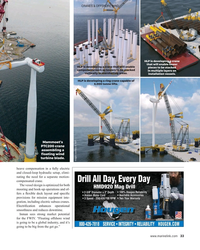 )
April 2024 - Maritime Reporter and Engineering News page: 33
)
April 2024 - Maritime Reporter and Engineering News page: 33CRANES & OFFSHORE WIND HLP is developing a crane that will enable tower HLP is developing a crane that will enable pieces to be stacked components such as towers to be stacked in multiple layers on vertically in marshalling areas. installation vessels. HLP is developing a ring crane capable of 6
-
 )
April 2024 - Maritime Reporter and Engineering News page: 32
)
April 2024 - Maritime Reporter and Engineering News page: 32Green, Engineering & For ? oating projects, it could reduce project installation time Contracts Director. “Ports are a major bottleneck at the mo- enough to make it comparable to ? xed wind, says Green. ment, certainly in Western Europe.” The development of the ? oating wind industry will be differ- The
-
 )
April 2024 - Maritime Reporter and Engineering News page: 27
)
April 2024 - Maritime Reporter and Engineering News page: 27and improve MSC’s advan- took all of those RRF ships and activated them, tage to retain and grow this critical workforce. We have six would we have enough mariners to man them? key initiatives that we started. I was the director of the 21st Yes. One time. But the problem is sustaining that. We don’t
-
 )
April 2024 - Maritime Reporter and Engineering News page: 25
)
April 2024 - Maritime Reporter and Engineering News page: 25RADM PHILIP SOBECK, MILITARY SEALIFT COMMAND Photo by Brian Suriani USN Military Sealift Command From a global supply chain perspective, What makes MSC so vital to the we’ve learned a lot about dealing with Navy’s ? eet and our military disruptions. COVID delivered a big forces around the world? wake-up
-
 )
April 2024 - Maritime Reporter and Engineering News page: 16
)
April 2024 - Maritime Reporter and Engineering News page: 16MARKETS SOVs – Analyzing Current, Future Demand Drivers By Philip Lewis, Director of Research, Intelatus © Björn Wylezich/AdobeStock t a high-level, there are three solutions to transferring Lower day rate CTVs are often used for daily transfer of technicians from shore bases to offshore wind farms
-
 )
April 2024 - Maritime Reporter and Engineering News page: 15
)
April 2024 - Maritime Reporter and Engineering News page: 15hydro-acoustic design of a propulsor that delays cavitation meets its underwater noise limits. This will require specialized inception and cavitating area. The third approach should be test sites or specialized mobile underwater testing equipment. isolation mounting of a vibro-active equipment and
-
 )
April 2024 - Maritime Reporter and Engineering News page: 14
)
April 2024 - Maritime Reporter and Engineering News page: 14Book Review Approach to Meeting Underwater Radiated Noise Limits Def ned By Raymond Fischer uantitative underwater radiated noise limits will construction inspections, 5) possible training with respect to be developed shortly by IMO, and/or countries salient design/construction essentials, 6) compliance
-
 )
April 2024 - Maritime Reporter and Engineering News page: 13
)
April 2024 - Maritime Reporter and Engineering News page: 13from gasoline to methanol, but compared to just buying an EV After some pondering, I think I can reduce it to this logi- today that is a pointless exercise. It would actually make more cal sequence: sense to buy a plug-in hybrid that is con? gured for methanol It is the carbon. We want zero carbon as
-
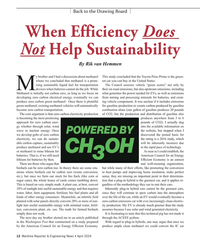 )
April 2024 - Maritime Reporter and Engineering News page: 12
)
April 2024 - Maritime Reporter and Engineering News page: 12Back to the Drawing Board When Efficiency Does Not Help Sustainability By Rik van Hemmen y brother and I had a discussion about methanol This study concluded that the Toyota Prius Prime is the green- where we concluded that methanol is a prom- est car you can buy in the United States. ising sustainable
-
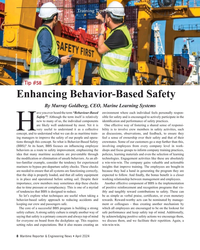 )
April 2024 - Maritime Reporter and Engineering News page: 8
)
April 2024 - Maritime Reporter and Engineering News page: 8Training Tips for Ships © By tuastockphoto/AdobeStock Tip #58 Enhancing Behavior-Based Safety By Murray Goldberg, CEO, Marine Learning Systems ave you ever heard the term “Behaviour-Based environment where each individual feels personally respon- Safety”? Although the term itself is relatively sible for
-
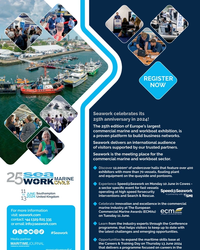 )
April 2024 - Maritime Reporter and Engineering News page: 7
)
April 2024 - Maritime Reporter and Engineering News page: 7REGISTER NOW Seawork celebrates its 25th anniversary in 2024! The 25th edition of Europe’s largest commercial marine and workboat exhibition, is a proven platform to build business networks. Seawork delivers an international audience of visitors supported by our trusted partners. Seawork is the
-
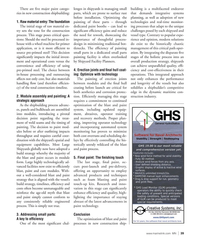 )
April 2024 - Marine News page: 39
)
April 2024 - Marine News page: 39There are ? ve major paint catego- lenges in shipyards is managing small building is a multifaceted endeavor ries in new construction shipbuilding: parts, which are prone to surface rust that demands integrative systems before installation. Optimizing the planning, as well as adoption of new 1.
-
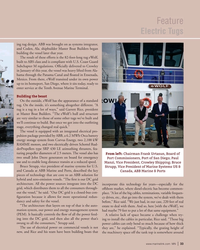 )
April 2024 - Marine News page: 33
)
April 2024 - Marine News page: 33Feature Electric Tugs ing tug design. ABB was brought on as systems integrator, and Coden, Ala. shipbuilder Master Boat Builders began building the vessel later that year. The result of these efforts is the 82-foot-long tug eWolf, built to ABS class and is compliant with U.S. Coast Guard Subchapter M
-
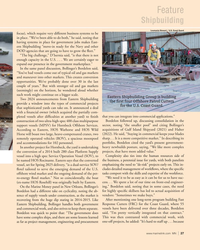 )
April 2024 - Marine News page: 27
)
April 2024 - Marine News page: 27“move-in ready for the Navy and other DOD agencies that are going to have to grow the ? eet.” “The big challenge,” D’Isernia said, “is that there is not enough capacity in the U.S. . . . We are certainly eager to expand our presence in the government marketplace.” In the same panel discussion, Bollinger’s
